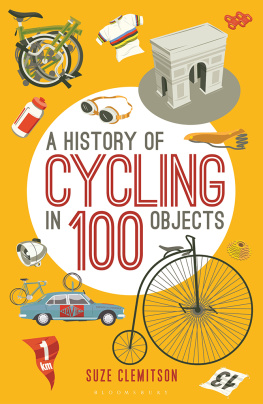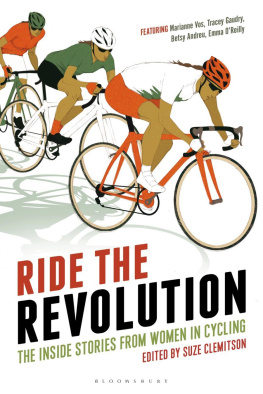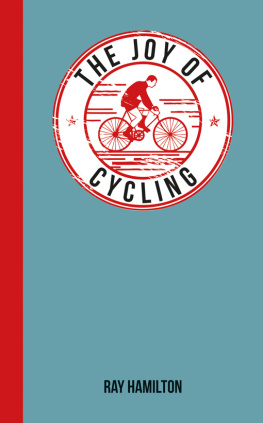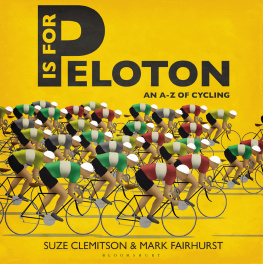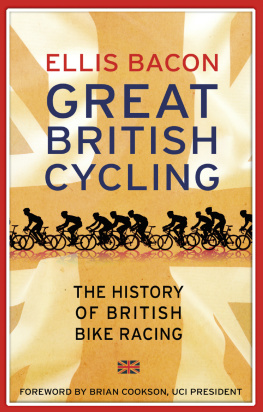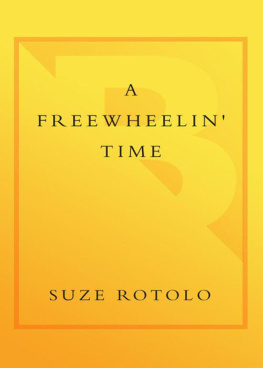Suze Clemitson - A History of Cycling in 100 Objects
Here you can read online Suze Clemitson - A History of Cycling in 100 Objects full text of the book (entire story) in english for free. Download pdf and epub, get meaning, cover and reviews about this ebook. year: 2017, publisher: Bloomsbury Publishing, genre: Home and family. Description of the work, (preface) as well as reviews are available. Best literature library LitArk.com created for fans of good reading and offers a wide selection of genres:
Romance novel
Science fiction
Adventure
Detective
Science
History
Home and family
Prose
Art
Politics
Computer
Non-fiction
Religion
Business
Children
Humor
Choose a favorite category and find really read worthwhile books. Enjoy immersion in the world of imagination, feel the emotions of the characters or learn something new for yourself, make an fascinating discovery.
- Book:A History of Cycling in 100 Objects
- Author:
- Publisher:Bloomsbury Publishing
- Genre:
- Year:2017
- Rating:4 / 5
- Favourites:Add to favourites
- Your mark:
- 80
- 1
- 2
- 3
- 4
- 5
A History of Cycling in 100 Objects: summary, description and annotation
We offer to read an annotation, description, summary or preface (depends on what the author of the book "A History of Cycling in 100 Objects" wrote himself). If you haven't found the necessary information about the book — write in the comments, we will try to find it.
A History of Cycling in 100 Objects — read online for free the complete book (whole text) full work
Below is the text of the book, divided by pages. System saving the place of the last page read, allows you to conveniently read the book "A History of Cycling in 100 Objects" online for free, without having to search again every time where you left off. Put a bookmark, and you can go to the page where you finished reading at any time.
Font size:
Interval:
Bookmark:


Bloomsbury Sport
An imprint of Bloomsbury Publishing Plc
| 50 Bedford Square | 1385 Broadway |
| London | New York |
| WC1B 3DP | NY 10018 |
| UK | USA |
www.bloomsbury.com
This electronic edition published in 2017 by Bloomsbury Publishing Plc
BLOOMSBURY and the Diana logo are trademarks of Bloomsbury Publishing Plc
First published in 2017
Text Suze Clemitson, 2017
Cover illustrations by Simon Scarsbrook
Suze Clemitson has asserted her right under the Copyright, Designs and Patents Act, 1988, to be identified as the Author of this work.
All rights reserved
You may not copy, distribute, transmit, reproduce or otherwise make available this publication (or any part of it) in any form, or by any means (including without limitation electronic, digital, optical, mechanical, photocopying, printing, recording or otherwise), without the prior written permission of the publisher. Any person who does any unauthorised act in relation to this publication may be liable to criminal prosecution and civil claims for damages.
ISBN: 978-1-4729-1888-8 (PB)
ISBN: 978-1-4729-1889-5 (eBook)
ISBN: 978-1-4729-1890-1 (ePDF)
To find out more about our authors and their books please visit www.bloomsbury.com where you will find extracts, author interviews and details of forthcoming events, and to be the first to hear about latest releases and special offers, sign up for our newsletters.
Photo Acknowledgements
Getty Images
LEquipe/Offside
the Marin Museum of Bicycling
M&N / Alamy Stock Photo
Sturmey-Archer Heritage
Gerard Brown
provided by Google Patents
Castelli
H. A. Roth, provided by ASSOS S.A.
Carson Blume
Arne Mill/frontalvision
courtesy of the Wellcome Collection
Bloomsbury Publishing
David Taylor
Edd Westmacott / Alamy Stock Photo
Dave Walker
courtesy of the University of California Libraries
Schwinn, courtesy of Pacific-Cycle
Contents
AUTHOR'S ACKNOWLEDGEMENTS
My thanks, as ever, to Charlotte Croft and Sarah Connelly at Bloomsbury for their unfailing support and skill at doing what they do so effortlessly well.
To Lucy Doncaster for her editorial flair and being so easy to work with and Nik Cook for casting a constructively critical and expertly technical eye across these pages.
Thanks also to the Co-The Cafe in Brantome for keeping me supplied with fabulous coffee and endless free WiFi when I had neither.
To every cycling writer who has written lucidly, coherently and brilliantly about the technical innovations that created cycling as both a sport and a pastime, my undying thanks for making my research so pleasurable.
And as ever, to my brilliant family, without whom I would never have written a word.
The Bicycles
Draisine |
It starts, quite literally, with a big bang. When Mount Tambora in Indonesia erupted in 1815, massive quantities of carbon dioxide entered the atmosphere and caused temperatures to drop worldwide, including Europe. In the Year Without A Summer that followed, crops across the region failed and famine and disease set in, resulting in horses being slaughtered for food and to save money and resources. Society now needed an alternative to costly horsepower, which is where Baron Karl von Drais big democratic idea of a (human) muscle-powered machine comes in.
Known variously around Europe as the Laufmaschine (the German for running machine); Draisine (after its inventor, Karl Friedrich Christian Ludwig, Baron Drais von Sauerbronn); vlocipde (the French for fast feet); and hobby horse or dandy horse in England (on account of the fact that it was deemed an expensive toy for rich dandies), the Draisine was a simple affair. Consisting of little more than a plank of wood joining two equal-sized wheels with a rudimentary saddle and steering system attached, it was used initially by Drais who was at that time working as a forester for the Grand Duke of Baden as a fast means of getting around his employers estate. Realising its potential, the intrepid Baron jumped astride his invention on 12 June, 1817 in the centre of Mannheim, he travelled 16km (10 miles) in just over an hour, marking the inception of horseless transport.
The Draisine was based on a simple premise that enabled riders to sit astride a frame and run along much like childrens balance bikes of today. A good idea in principle; in practice the terrible state of European roads made striding and balancing both dangerous and uncomfortable and the design was soon superseded.
In England, in 1818, just a year after the Draisines inaugural outing, London-based coach-maker Denis Johnson began manufacturing his hobby horse, which was a lighter, improved version of the Draisine featuring larger wheels and, for the ladies, a model with a dropped, curved frame that was easier to mount in style. This proved very popular among the wealthy classes and the craze soon reached the USA, where many examples were made and could be hired for use in one of the specially constructed riding rinks (similar to skating rinks, but made of wood). Despite its popularity, however, the fad was short-lived because its lack of practical use along with its nickname, the dandy horse. By the 1820s, the Draisine and its imitators were a footnote in transport history.
But what of the man behind the machine? Born into a noble family in 1785, in Karlsruhe, Germany, Drais was a democrat whose egalitarian views got him into trouble with both his aristocratic peers and the authorities. A supporter of the failed German Revolution of 1848, he had previously spent several years in exile in Brazil, survived an assassination attempt in 1838, and been very much a persona non grata in high society. Despite these factors, this one-time civil servant and professor of mechanics was prolific in his inventions, which included a meat grinder that is still used today, a typewriter, a machine to record piano music on paper, a stenotype machine and a quadricycle. It was the Draisine, however, for which he is most remembered because it set in motion a series of inventions that would eventually culminate in the modern bicycle. Drais never saw a penny as a civil servant he wasnt allowed to patent his invention and the government pension he received was stripped away by the Royalists in the aftermath of the revolution. He died penniless in Karlsruhe in 1851.

The hobby horse, invented in 1817, was the big bang for the modern bicycle. Hobby horses had no pedals or brakes, instead they were propelled by the rider pushing on the ground with his feet and dragging to slow the machine.
Boneshaker or vlocipde |
If the Draisine was the Big Bang for the bicycle, then the missing link between hobby horses and pedal power was the boneshaker or vlocipde (the latter name had also been used for the Draisine, but became a generic term for a human-powered wheeled land vehicle with the advent of the boneshaker in the 1860s).
This missing link was heavy and horribly uncomfortable to ride, often leaving its passengers black and blue after a spin (which accounts for its English nickname). Despite this, the boneshaker was important because it enabled riders to travel far greater distances than the Draisine, and with their feet off the ground, all because it possessed a rudimentary set of pedals.
Font size:
Interval:
Bookmark:
Similar books «A History of Cycling in 100 Objects»
Look at similar books to A History of Cycling in 100 Objects. We have selected literature similar in name and meaning in the hope of providing readers with more options to find new, interesting, not yet read works.
Discussion, reviews of the book A History of Cycling in 100 Objects and just readers' own opinions. Leave your comments, write what you think about the work, its meaning or the main characters. Specify what exactly you liked and what you didn't like, and why you think so.

